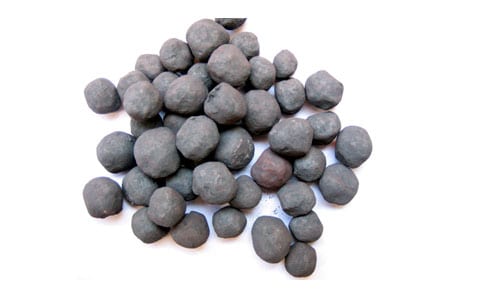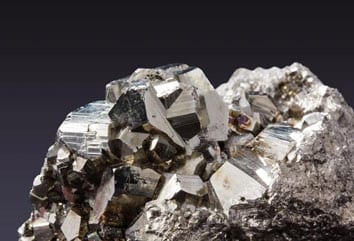زبان منتخب کریں:
Iron ore is the fourth most common element in the earth’s crust. Iron is essential to steel manufacturing and, therefore, an essential material for global economic development. لوہے کو گاڑیوں کی تعمیر اور مینوفیکچرنگ میں بھی بڑے پیمانے پر استعمال کیا جاتا ہے. Most iron ore resources are composed of metamorphosed banded iron formations (بی آئی ایف), جس میں لوہا عام طور پر آکسائڈ کی شکل میں پایا جاتا ہے۔, hydroxides, اور, to a lesser extent, carbonates.
The chemical composition of iron ores is apparent to be wide, especially for Fe content and associated gangue minerals. Major iron minerals associated with most iron ores are hematite, گویٹہاٹی, limonite, and magnetite. لوہے کے اجزاء میں اہم آلودہ عناصر ایس آئی او 2 اور ایل 2 او 3 ہیں۔. The typical silica and alumina-bearing minerals present in iron ores are quartz, کاؤلاناٹی, گبندا, diaspore, and corundum. ان میں سے, it is often observed that quartz is the main silica-bearing mineral, and kaolinite and gibbsite are the two main alumina-bearing minerals.


Iron ore extraction is mainly performed through open pit mining operations, جس کے نتیجے میں اہم ٹیلنگ پیدا ہوتی ہے. لوہے کی پیداوار کے نظام میں عام طور پر تین مراحل شامل ہوتے ہیں: کان کنی, پروسیسنگ, and pelletizing activities. Processing ensures that an adequate iron grade and chemistry are achieved prior to the pelletizing stage. پروسیسنگ میں کرشنگ شامل ہے, درجہ بندی, ملنگ, and concentration, with the aim of increasing the iron content while reducing the amount of gangue minerals. Each mineral deposit has its own unique characteristics with respect to iron and gangue-bearing minerals, and therefore, it requires a different concentration technique.
Magnetic separation is typically used in high-grade iron ore beneficiation, where the dominant iron minerals are ferro and paramagnetic. گیلے اور خشک کم شدت کی مقناطیسی علیحدگی (LIMS) techniques are used to process ores with strong magnetic properties, such as magnetite, while wet high-intensity magnetic separation is used to separate the Fe-bearing minerals with weak magnetic properties, such as hematite, from gangue minerals. Iron ores such as goethite and limonite are commonly found in tailings and do not separate very well by either technique.

فلوٹیشن کا استعمال کم درجے کے لوہے کے اجزاء میں گندگی کے مواد کو کم کرنے کے لئے کیا جاتا ہے. لوہے کے اجزاء کو یا تو آئرن آکسائڈ کے براہ راست اینیونک فلوٹیشن یا سلیکا کے ریورس کیٹیونک فلوٹیشن کے ذریعہ مرکوز کیا جاسکتا ہے۔; تاہم, reverse cationic flotation remains the most popular flotation route used in the iron industry. The use of flotation is limited by the cost of reagents, the presence of silica and alumina-rich slimes, and the presence of carbonate minerals. علاوہ, flotation requires wastewater treatment and the use of downstream dewatering for dry final applications.
The use of flotation for the concentration of iron also involves desliming, as floating in the presence of fines results in decreased efficiency and high reagent costs. ایلومینا کو ہٹانے کے لئے ڈیسلیمنگ خاص طور پر اہم ہے کیونکہ کسی بھی سطح پر فعال ایجنٹوں کے ذریعہ گبسائٹ کو ہیماٹائٹ یا گوئٹائٹ سے الگ کرنا کافی مشکل ہے۔. Most alumina-bearing minerals occur in the finer size range (<20um), ڈی سلیمنگ کے ذریعے اسے ہٹانے کی اجازت دینا. مجموعی طور پر, جرمانوں کا ایک بڑا ارتکاز (<20um) اور ایلومینا مطلوبہ کیٹیونک کلکٹر خوراک میں اضافہ کرتا ہے اور انتخاب کو ڈرامائی طور پر کم کرتا ہے۔. پس, desliming increases flotation efficiency but results in a large volume of tailings and in loss of iron to the tailings stream.
لوہے کی خشک پروسیسنگ فلوٹیشن اور گیلے مقناطیسی علیحدگی سرکٹس سے وابستہ اخراجات اور گیلے ٹیلنگ کی پیداوار کو ختم کرنے کا موقع پیش کرتی ہے۔. STET has evaluated several iron ore tailings and run-of-mine ore samples at bench scale (پری فزیبلٹی اسکیل). لوہے اور سلیکیٹس کی نمایاں نقل و حرکت دیکھی گئی, ذیل کے جدول میں نمایاں مثالوں کے ساتھ.

اس مطالعے کے نتائج سے پتہ چلتا ہے کہ ایس ٹی ای ٹی ٹریبو-الیکٹراسٹک بیلٹ جداکار کے ذریعہ کم درجے کے لوہے کے لوہے کے فائن کو اپ گریڈ کیا جاسکتا ہے۔. ایس ٹی ای ٹی کے تجربے کی بنیاد پر, پائلٹ اسکیل پروسیسنگ میں مصنوعات کی بازیابی اور / یا گریڈ میں نمایاں بہتری آئے گی, ان لوہے کے تجربات کے دوران استعمال ہونے والے بینچ اسکیل ٹیسٹ ڈیوائس کے مقابلے میں.
The STET dry electrostatic fine iron ore separation process offers many advantages over traditional wet processing methods, جیسے مقناطیسی یا فلوٹیشن, سمیت:
Contact us to learn more about dry processing of iron ore.
حوالے:
Iron ore beneficiation involves a series of processes that aim to improve the purity and quality of raw iron ore. These processes include crushing, grinding, magnetic separation, flotation, and gravity separation, depending on the mineralogical characteristics of the ore. Each technique is selected based on the ore’s composition and feasibility to extract the maximum amount of iron while minimizing impurities.
Iron ore mining requires specialized equipment to handle the extraction and processing of ore. Common machinery includes ball mills for grinding, crushers for reducing the size of ore, magnetic separators for separating iron particles from impurities, flotation machines for fine particle separation, and conveyors for transport.
Technologies utilized for iron ore beneficiation include advanced techniques such as dry electrostatic separation, flotation, advanced gravity separation, and sensor-based sorting. These technologies aim to efficiently increase the iron content and eliminate contaminants, catering to the growing demand for high-grade iron ore and promoting sustainable mining practices.
The cost of iron ore beneficiation can vary significantly depending on the specific processes and technologies used, the grade of the raw ore, and the desired purity of the final product. It encompasses capital expenditure (CapEX), such as equipment and plant construction, and operational expenditure (OPEX), including labor, energy, and consumables. It’s essential for companies to evaluate these costs against prospective revenue and market demands to ensure project viability.